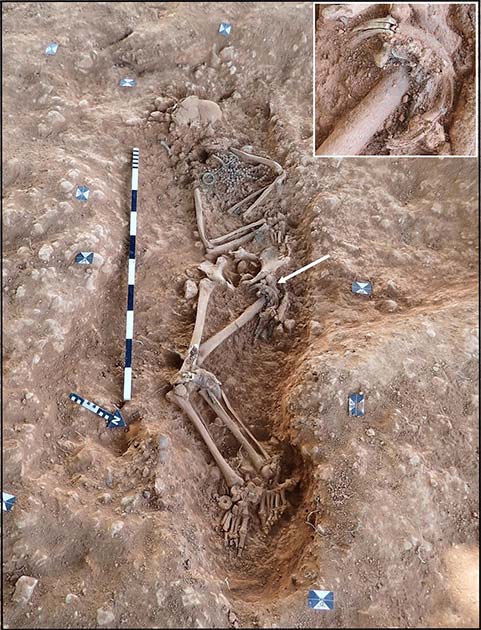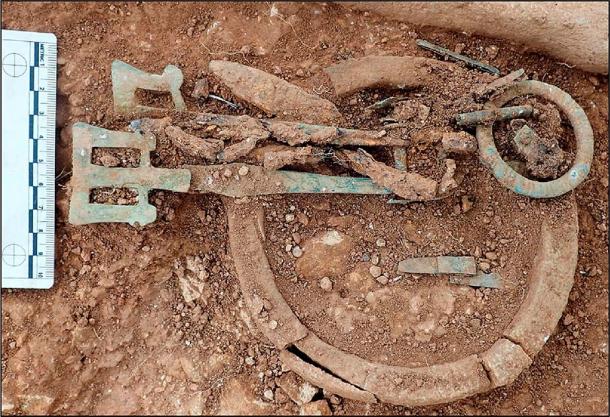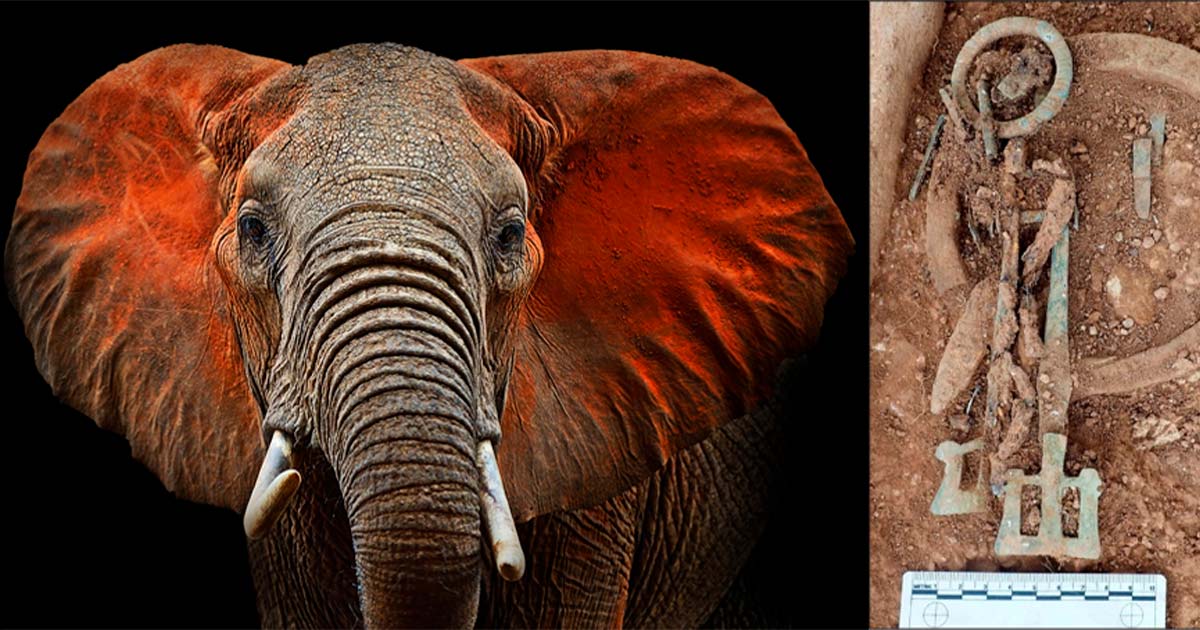Anglo-Saxon Ivory Rings Found in Britain Came from African Elephants
Unusual rings made from ivory have been unearthed in dozens of early Anglo-Saxon burials in England. The origin of the Anglo-Saxon ivory rings had remained a mystery for 200 years, but scientific testing carried out by a team of researchers from multiple universities in the UK has revealed that the ivory came from African elephants who lived in the fifth and sixth centuries AD.
The researchers, who have just published the results of their study in the Journal of Archaeological Science: Reports, were even able to determine that the elephants lived in East Africa. This means that the ivory was actually sourced nearly 4,000 miles (6,400 km) away from the cemeteries in which the Anglo-Saxon ivory rings were found.
- Blood-Stained Ivory: The Dark History of the Trade in Elephant Tusks
- The Elephant Slabs of Flora Vista: Enigmatic Artifacts with Ancient African Origins
This is an extraordinary distance for ivory to have been transported, given what is known about travel and trade in the first millennium AD. Nevertheless, this remarkable discovery suggests that a trading network must have existed at that time that connected eastern Africa with western Europe, despite the incredible separation in distance.
“It's really a long way,” University of Sheffield archaeologist and study co-author Hugh Willmott told Live Science. “It's crossing the Mediterranean world, and then the Alps, and then probably going via the Rhineland… so it's crossing multiple cultures.”
Anglo-Saxon Ivory Rings of Honor and Status Unearthed in England
Anglo-Saxon ivory rings have been discovered inside excavated graves in approximately 70 cemeteries in central, eastern and southern England. They have been found exclusively in the graves of elite Anglo-Saxon women who lived between the late fifth and early seventh centuries. Archaeologists know these were women of wealth and importance, since their tombs were furnished with elaborate collections of valuable grave goods.
The rings themselves are somewhat enigmatic, as they resemble rings worn on fingers in shape but are much too large to have fulfilled that purpose. This indicates they were not jewelry and must have been used for something else.
The current working hypothesis is that they were bag rings, made to hold open small cloth bags that were worn around the waist. Presumably such bags were worn as a fashion statement, and the use of rings made from valuable ivory to keep them open suggests they were viewed as a luxury item.
Until now, researchers had only been able to speculate about the rings’ origins. They weren’t certain if the ivory used to make them had come from elephants, walruses or mammoths. Before this study, they didn’t know where it had been collected or purchased.

Burial of an Anglo-Saxon female unearthed in Scremby, Lincolnshire. The ivory ring bag was found at her left hip. (Hemer et. al / Journal of Archaeological Science / CC BY-NC-ND 4.0)
Analysis of Anglo-Saxon Ivory Ring Provides Answers
The team of UK researchers performed an extensive analysis of a single bag ring, which was taken from an early Anglo-Saxon burial found in an ancient cemetery near the village of Scremby in Lincolnshire. This cemetery was in use from the late fifth through the early sixth centuries, and the ring was one of seven removed from excavated Anglo-Saxon graves.
To discover which animal the ivory came from, the researchers removed a sample of collagen for chemical analysis. Collagen is the most abundant protein in the bodies of mammals, and it can be found in ivory samples even if they are several centuries old.
Using this methodology, the researchers were able to prove that the ivory came from the tusk of an African elephant. They also performed a radiocarbon dating test on the ring, and this showed that the elephant had lived in the fifth century AD.
With this information in hand, the research team then took measurements of the ivory’s strontium isotope ratios. Strontium is an element absorbed by animals from the surrounding environment, and by measuring its different forms in a biological sample it is possible to tell where an ancient animal lived before it died.
In this case, the strontium measurements showed that the ivory had come from an elephant living in a geological area with a lot of young volcanic rocks. According to Hugh Willmott, this indicates that the elephant lived in the Rift Valley region of East Africa—which is 4,000 miles away from the cemetery where the ivory ring was found.
“This study may add to the growing body of evidence suggesting that trading networks of the fifth- to seventh- centuries were far more extensive and complex than often previously supposed,” Ken Dark, an archaeologist from King’s College in London who studies first millennium trade networks in Europe, told Live Science.

Anglo-Saxon ivory ring bag and girdle hangers discovered at burial in Scremby. (Hemer et. al / Journal of Archaeological Science / CC BY-NC-ND 4.0)
Tracking the Long-Distance Ivory Trade in the First Millennium AD
Archaeologists unearthed the first bag rings in England more than two centuries ago. Hundreds have been removed from Anglo-Saxon burials over the years, and a few have even been found at gravesites outside the UK, in northwestern Europe.
The rings are large, measuring between four and six inches (10 to 15 cm) in diameter. They have only been found in the graves of wealthy Anglo-Saxon women, often right alongside curious collections of small artifacts. Archaeologists have concluded these items must have been stored in cloth bags attached to the rings, and when the bags decayed into oblivion the items spilled out in mixed piles.
- Mighty Anglo-Saxon Warrior Grave May Throw Light On the Dark Ages
- Shadows of the Dead: Anglo-Saxon Burials are Spooky Sand Silhouettes
Willmott noted that the objects that were once held in these bags “tend to be quite random. Broken Copper, Roman coins, things like that.” In other words, the bags were the equivalent of purses today, employed to hold items used on a daily basis. Ancient purses attached to ivory rings undoubtedly would have been coveted by Anglo-Saxon women rich enough to afford them.
Because no ivory workshops have ever been found at Anglo-Saxon sites, the researchers believe the ivory would have been carved into rings in Africa before being exchanged or sold as value-added items. Notably, excavations at Eastern African sites linked to the ancient Christian Kingdom of Aksum (modern-day Eritrea and northern Ethiopia) have unearthed significant evidence of ivory working. Meanwhile, historical literature refers to the Aksumites as major dealers of high-quality ivory items from the third through the seventh centuries AD.
On the Anglo-Saxons end, previous excavations have already established that they were importing goods from elsewhere into England during the first millennium. Valued items that Anglo-Saxon elites acquired through trade included amber beads from the Baltic region, cowrie shells from India or the Red Sea region, amethyst beads from the eastern Mediterranean and glass containers from France.
Up to now, what has been missing is solid evidence relating to the specific trade routes that were used to bring these objects to the British Isles. But as this new study makes clear, the geographical range of available trade routes 1,500 years ago must have been quite impressive.
The Anglo-Saxon ivory rings were apparently imported into England for over 100 years. But their use seems to have stopped in the seventh century, possibly because the African ivory trade with Aksum was interrupted following the expansion of Islamic people into North Africa. The newcomers may have seized control of ivory resources in the region, ultimately changing the dynamics of ivory exchange not just in Africa but in the world at large.
Top image: Anglo-Saxon ivory rings were sourced from African elephants. Source: kyslynskyy / Adobe Stock
By Nathan Falde

















